Pennsylvania III (Battleship No. 38)
1916-1946
Pennsylvania, second of the original 13 states, ratified the Constitution on 12 December 1787.
III
(Battleship No. 38: displacement 31,400; length 608'; beam 97'1"; draft 28'10"; speed 21 knots; complement 915; armament 12 14-inch, 14 5-inch, 4 3-inch, 4 3-pounders, 2 21-inch torpedo tubes (submerged); class Pennsylvania)
The third Pennsylvania (Battleship No. 38) was laid down on 27 October 1913 at Newport News, Va., by the Newport News Shipbuilding & Dry Dock Co.; launched on 16 March 1915; sponsored by Miss Elizabeth Kolb, daughter of Louis J. Kolb, a friend of Governor Martin G. Brumbaugh of Pennsylvania; and commissioned on 12 June 1916, Capt. Henry B. Wilson in command.
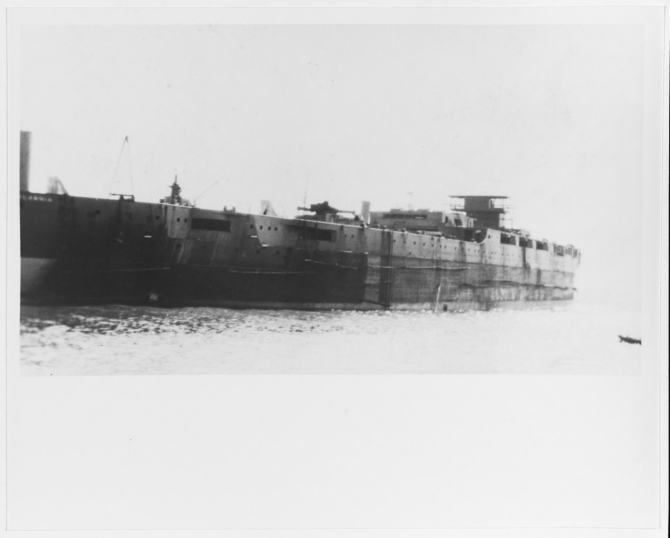
Pennsylvania fitting out at Newport News, Va., 23 April 1915. Collection of Gilman L. Smith. (Naval History and Heritage Command Photograph NH 93528)
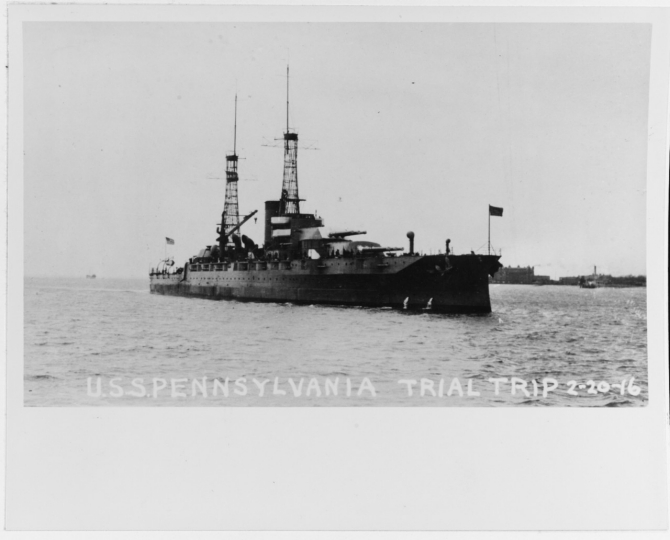
Pennsylvania off Newport News on her trial trip, 20 February 1916. (Naval History and Heritage Command Photograph NH 89492)
Pennsylvania was attached to the U.S. Atlantic Fleet and fitted out at the Norfolk (Va.) Navy Yard (1-20 July 1916). She put to sea for her trials moving on to the Southern Drill Grounds (20-22 July) and then to northeastern waters off New England and Long Island. She was off Martha’s Vineyard (25 July), at Newport, R.I. and off the Benton Reef Lightship (R.I.) (26-27 July), and Fort Pond Bay, Montauk, N.Y., (29 July-1 August). On 21 August, Rear Adm. Austin M. Knight and staff from the Naval War College came on board at Newport and the ship put to sea for fleet exercises. On 24 August, Assistant Secretary of the Navy Franklin D. Roosevelt shifted from Rhode Island (Battleship No. 17) to Pennsylvania and broke the flag of the Assistant Secretary of the Navy at the main. Roosevelt remained on board until the following afternoon.
On 12 October 1916, Pennsylvania became flagship of Commander in Chief, U.S. Atlantic Fleet, when Rear Adm. Henry T. Mayo shifted his flag from Wyoming (Battleship No. 32). The battleship spent Christmas Day at the New York Navy Yard.
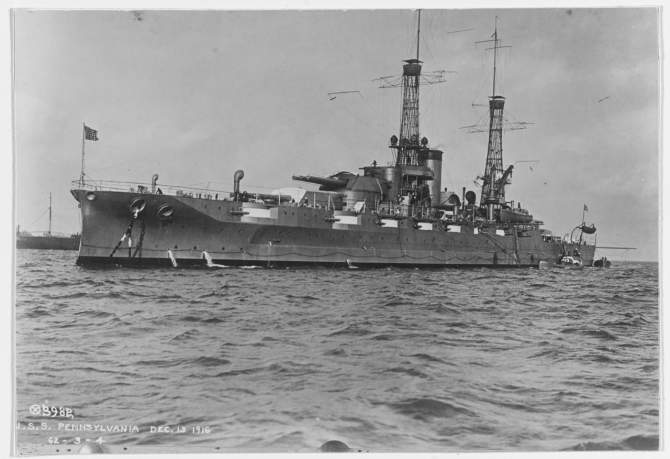
Pennsylvania, 13 December 1916. (Naval History and Heritage Command Photograph NH 42729)
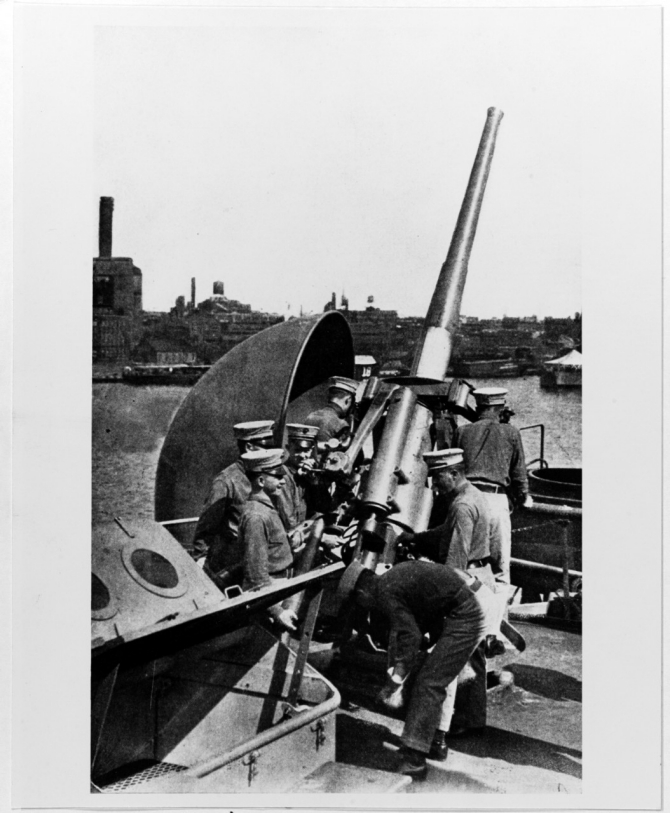
Ship's marines exercise with a 3-inch/50 anti-aircraft gun prior to World War I. Published in The United States Navy Illustrated, C.S. Hammond and Company, New York, 1917. (Naval History and Heritage Command Photograph NH 79493)
In January 1917, Pennsylvania steamed for fleet maneuvers in the Caribbean, calling at Culebra Island, Puerto Rico; Santo Domingo, Dominican Republic; and Port-au-Prince, Haiti. During the visit to the Haitian capital, on 26 January, Assistant Secretary Roosevelt shifted from the destroyer Wainwright (Destroyer No. 62) and hosted the President of Haiti on board the battleship. After maneuvers in Caribbean waters, Pennsylvania returned to her base at Yorktown, Va., on 6 April 1917, the day of the declaration of war against Germany.
Pennsylvania did not sail to join the British Grand Fleet as she burned fuel oil and tankers could not be spared to carry additional fuel to the British Isles. In light of that circumstance and given that coal was plentiful in the British Isles, only coal burning battleships were selected for deployment to European waters.
While at Yorktown, on 11 August 1917, Pennsylvania manned the rail and rendered honors as, with President Woodrow Wilson on board, the converted yacht Mayflower stood in and anchored. At 12:15 p.m., President Wilson returned the call of Commander, Battle Force on board Pennsylvania and received full honors. He then delivered to Rear Adm. Mayo and officers of the Atlantic Fleet, the president noted that “We are hunting hornets all over the farm and letting the nest alone. None of us knows how to go to the nest and crush it, yet I despair of hunting for hornets all over the sea when I know where the nest is and know that the nest is breeding hornets as fast as I can find them. I am willing for my part, and I know you are willing because I know the stuff you are made of, I am willing to sacrifice half the navy Great Britain and we together have to crush that nest, because if we crush it, the war is won.”
Among the notable visitors to the battleship were Vice Adm. Takeshita Isamu and his aide, Cmdr. Ando Shigeki, of the Imperial Japanese Navy, who came on board on 9 September and remained for a week to observe Atlantic Fleet maneuvers. On 30 September, Vice Adm. Aleksander V. Kolchak of the Imperial Russian Navy, and Lt. Makarov, his aide, came on board, remaining until 6 October. Adm. William S. Benson, Chief of Naval Operations (CNO), on 7 December 1917, ordered the removal of two five-inch guns, mounts, accessories, and spare parts from Pennsylvania along with the battleships Nevada (Battleship No. 36), Arizona (Battleship No. 39), Texas (Battleship No. 35), Oklahoma (Battleship No. 37), Arkansas (Battleship No. 33), Kearsarge (Battleship No. 5), and Kentucky (Battleship No. 6).
Pennsylvania kept in battle trim with various fleet exercises and gunnery practices in the training areas of the Chesapeake Bay and Long Island Sound. Adm. Benson, on 30 July 1918, specified plans to station Battleship Division 6 (BatDiv6) Utah (Battleship No. 31), Nevada, and Oklahoma, at Queenstown or Brest, and hold Battleship Division Five (BatDiv5), Arizona, Mississippi (Battleship No. 41, New Mexico (Battleship No. 40), and Pennsylvania, to cover the western Atlantic or proceed where necessary. The Navy Department also asked the State Department to request the Japanese government to detail a division of battlecruisers to join the Atlantic Fleet at Hampton Roads and conduct search operations.
On the day of the Armistice, 11 November 1918, she was preparing to conduct a night battle practice and when the German High Seas Fleet surrendered at Scapa Flow, Orkney Islands, on 21 November, the battleship came out of dry dock at the New York Navy Yard.
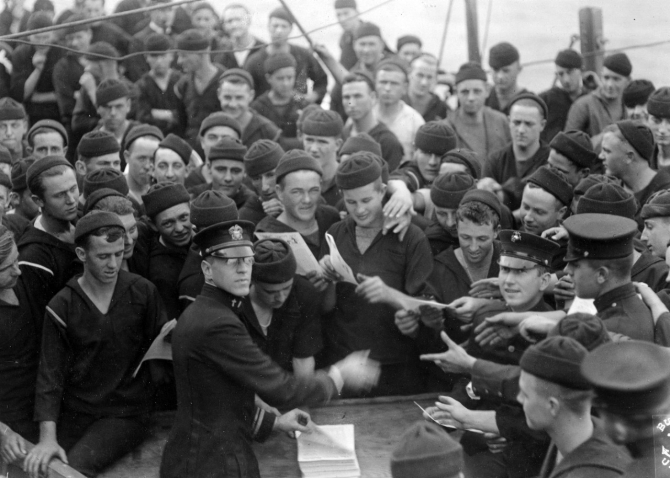
Chaplain distributing the Pennsylvania ship's newspaper to sailors and marines of her crew, circa 1918. Almost all the sailors present are wearing knitted watch caps. (Naval History and Heritage Command Photograph NH 3027)
On 2 December 1918, Pennsylvania steamed to the anchorage off Tompkinsville, N.Y., and two days later sailed for Brest, France. At 1100 that day, the troop transport George Washington (Id. No. 3018), flying the flag of the President of the United States, stood out with an escort of ten destroyers. Pennsylvania manned the rail and fired a salute of 21 guns. She then took position ahead of George Washington as guide for the President's escort. The following day, five of the escorting destroyers returned to port.
Pennsylvania reached Brest on 13 December 1918, where her sailors manned the rail and cheered as George Washington passed and proceeded to her anchorage. The following day, 14 December, Pennsylvania with the Sixth and Ninth Battleship divisions got underway for New York, and while en route home on 20 December encountered heavy seas, rolling heavily. On 26 December, the battleships entered New York harbor; passed Mayflower anchored off the Statue of Liberty with Secretary of the Navy Josephus Daniels embarked; each fired a 19-gun salute; and anchored in the North River. Battalions from the various ships formed and paraded through the streets of New York celebrating the end of hostilities.
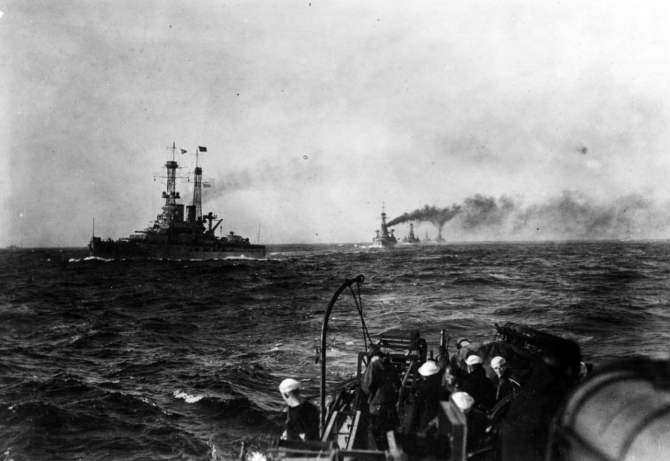
Pennsylvania and the Sixth Battle Squadron of the Grand Fleet escorting George Washington (Id. No. 3018) to Brest, on 13 December 1918. This was President Wilson's first visit to France. (Naval History and Heritage Command Photograph NH 469)
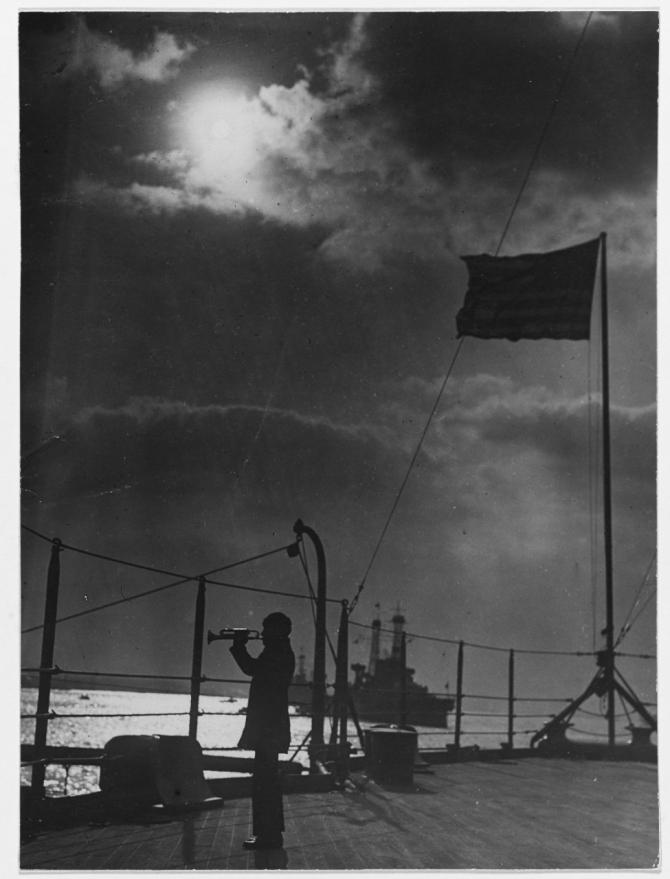
A bugler sounds a call on Pennsylvania’s fantail, circa 1918. Other units of the Battle Fleet are in the background. (Naval History and Heritage Command Photograph NH 42746)
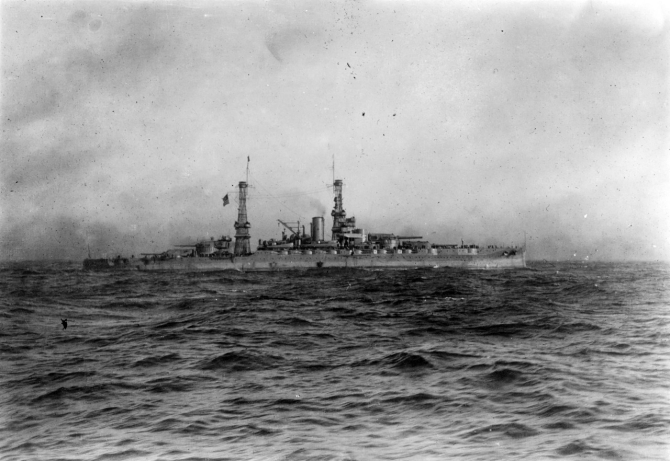
Pennsylvania off Brest, France, while escorting President Wilson to France, 13 December 1918. Photographed by Zimmer. (Naval History and Heritage Command Photograph NH 3021)
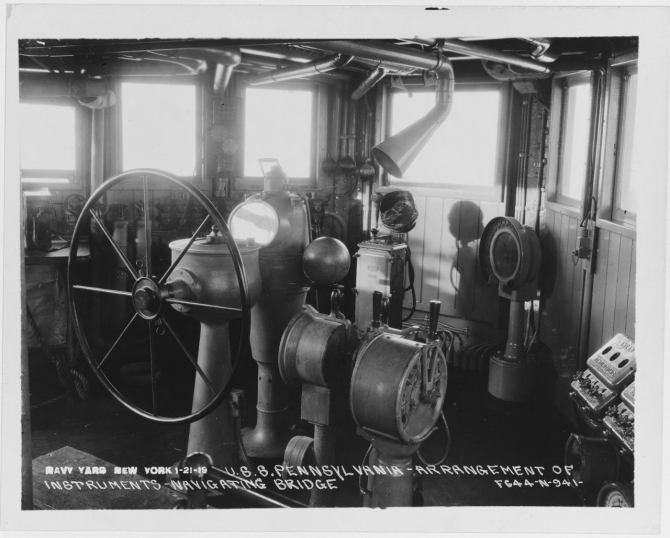
Arrangement of instruments on navigating bridge, New York Navy Yard, 21 January 1919. (Naval History and Heritage Command, NH 76572)
In February 1919, Pennsylvania and the Atlantic Fleet steamed for the Caribbean Sea to conduct maneuvers and gunnery practices off Cuba. She returned to New York on 14 April 1919.
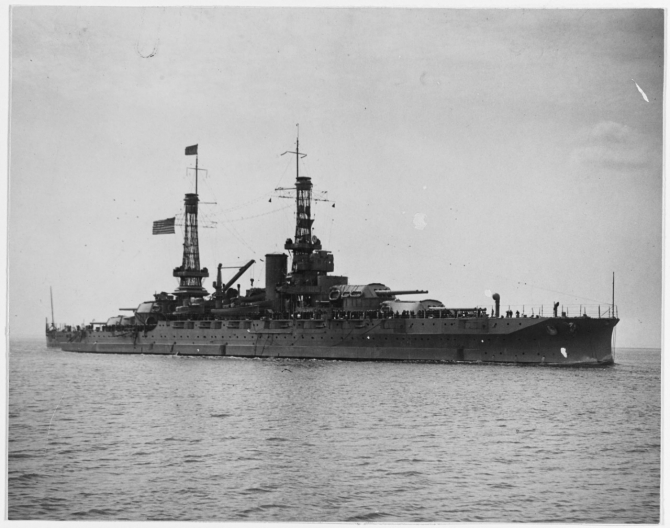
Pennsylvania, Flagship of Atlantic Fleet Commander, Adm. Henry T. Mayo, steams into New York Harbor with the "Victory Fleet” on 14 April 1919 following target practice in Cuban waters. (Naval History and Heritage Command Photograph NH 42734)
While at New York on 30 June 1919, Adm. Mayo was relieved as Commander in Chief, U.S. Atlantic Fleet, by Vice Adm. Henry B. Wilson. At Tompkinsville, N.Y., on 8 July 1919, Pennsylvania embarked Vice President Thomas R. Marshall, Cabinet Secretaries Josephus Daniels, Carter Glass, William B. Wilson, Newton D. Baker, and Franklin K. Lane, and Senator James B. “Champ” Clark, and then put to sea. At 1000, Oklahoma (Battleship No. 37) was sighted with George Washington flying the President's flag and accompanied by her ocean escort. Pennsylvania fired a presidential salute, then took position ahead of Oklahoma and steamed to New York, stopping en route to disembark her distinguished guests before proceeding to her berth.
Pennsylvania departed New York for Fleet maneuvers in the Caribbean on 7 January 1920, returning to New York on 26 April 1920. Afterward, she resumed a schedule of local training operations, and that summer was designated BB-38 on 17 July 1920.
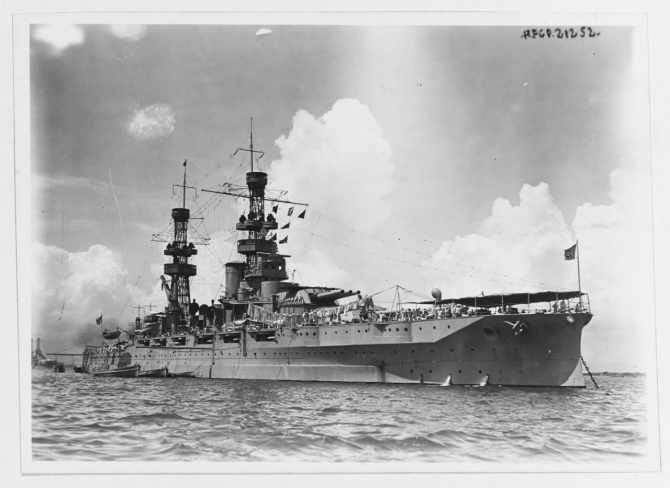
Pennsylvania, circa 1920. Collection of Gustave Maurer. (Naval History and Heritage Command Photograph NH 1624).
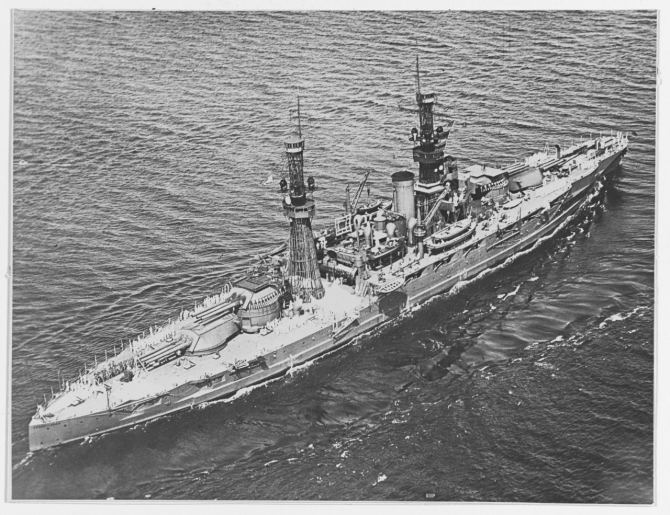
Pennsylvania underway, circa 1920. (Naval History and Heritage Command Photograph NH 42741)
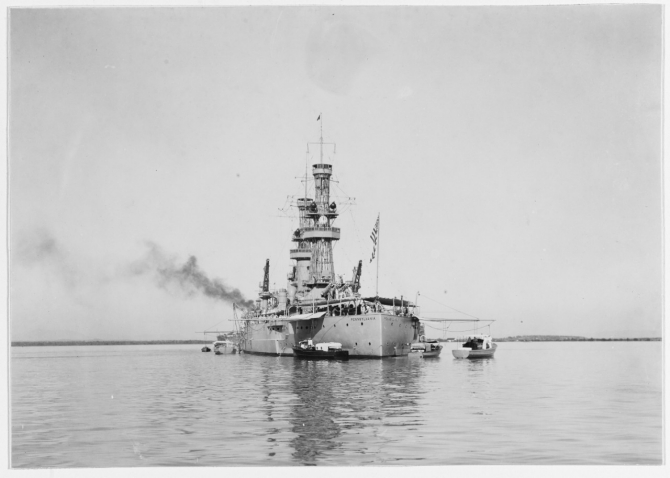
Pennsylvania in Guantanamo Bay, Cuba, early in 1920. Note Flag Officer's barge at her stern. (Naval History and Heritage Command Photograph NH 42738)
Pennsylvania steamed for the Panama Canal from New York on 17 January 1921, arrived at Balboa, Canal Zone (C.Z.) on 20 January, and joined units of the Pacific Fleet. She became flagship of the combined fleets, the Commander in Chief, U.S. Atlantic Fleet assuming command of the U.S. Battle Fleet on orders of the Navy Department. On 21 January 1921, the fleet sailed from Balboa, en route to Callao, Peru, arriving on 31 January 1921. Departing on 2 February, Pennsylvania returned to Balboa on14 February, then conducted brief exercises while based at Guantanamo Bay, Cuba. Upon her return to Hampton Roads, on 28 April 1921, she rendered a 21-gun salute as she passed Mayflower. Secretary of the Navy Edwin Denby, the Chief of Naval Operations Adm. Robert E. Coontz, and the Assistant Secretary of the Navy Theodore Roosevelt Jr. came on board for a reception to the President of the United States. At 1140, President Warren G. Harding embarked and his flag was broken at the main.
Pennsylvania arrived on the Southern Drill Grounds in the Caribbean on 12 July 1921 and conducted tactical exercises and gunnery training until 21 July when she departed for New York and the anchorage at North River. Reaching the next day, she remained until 30 July when she weighed anchor bound for Plymouth, Mass. Arriving the next day, Pennsylvania stayed until 2 August when she departed for a return to New York. She entered the New York Navy Yard on 5 August and underwent a maintenance period until 20 August, when she set course for the Delaware Breakwater enroute to Lynnhaven Roads, Va., reaching on 22 August. Departing that same day, Pennsylvania headed to Colon, C.Z. Arriving on 30 August, she passed through the Panama Canal to the Pacific. She remained at Balboa until departing, on 15 September, bound for San Pedro, Calif., where she anchored on the 26th. She stood at San Pedro until 2 December, when she got underway for San Francisco. Arriving on 4 December, Pennsylvania remained at San Francisco until the 17th, then returned to San Pedro on the 19th.
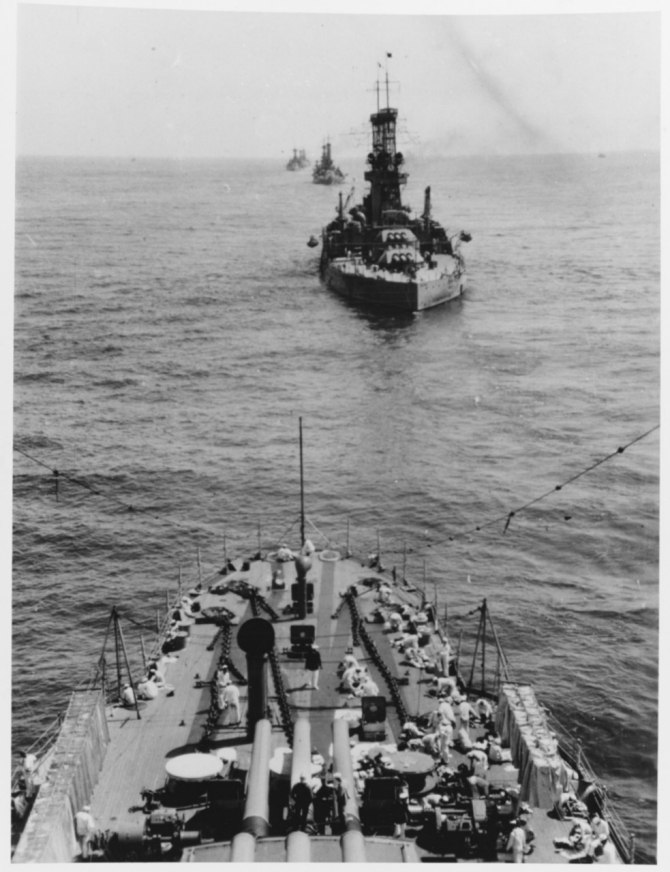
Pennsylvania steaming with the battle fleet during the early 1920s. Her crewmembers are doing laundry on the forecastle. Courtesy of Lt. Gustave Freret. (Naval History and Heritage Command Photograph NH 74647)
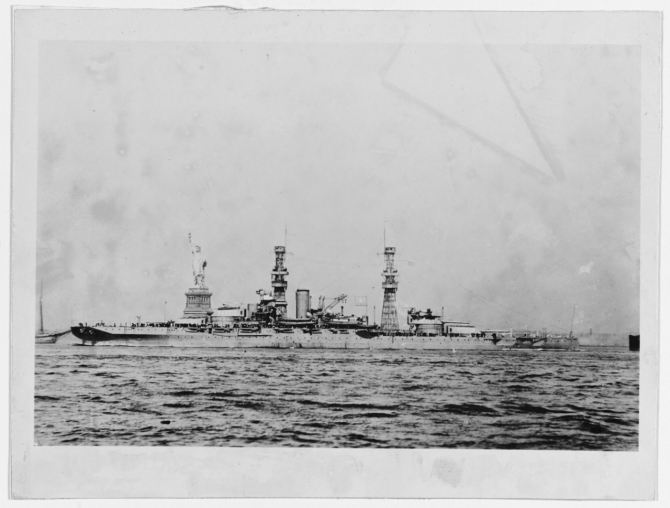
Pennsylvania in New York Harbor with the Statue of Liberty beyond her, during the early 1920s. Note planes atop her turrets, and short-range battle practice target rigged amidships. (Naval History and Heritage Command Photograph NH 42742)
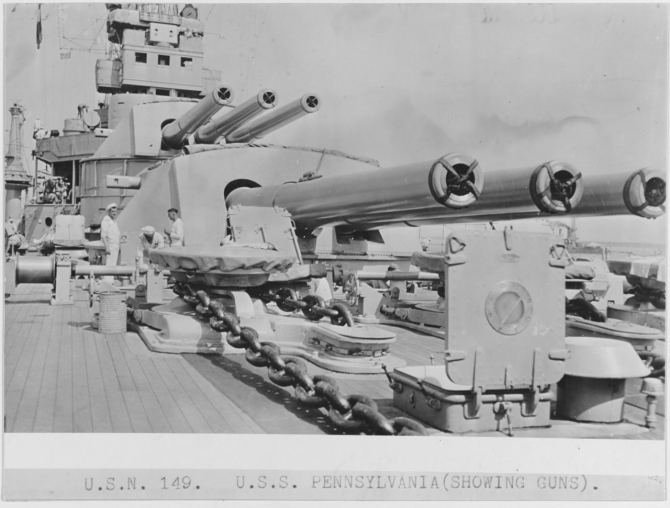
Six of Pennsylvania’s 14-inch/45 caliber guns. (Naval History and Heritage Command Photograph NH 123901)
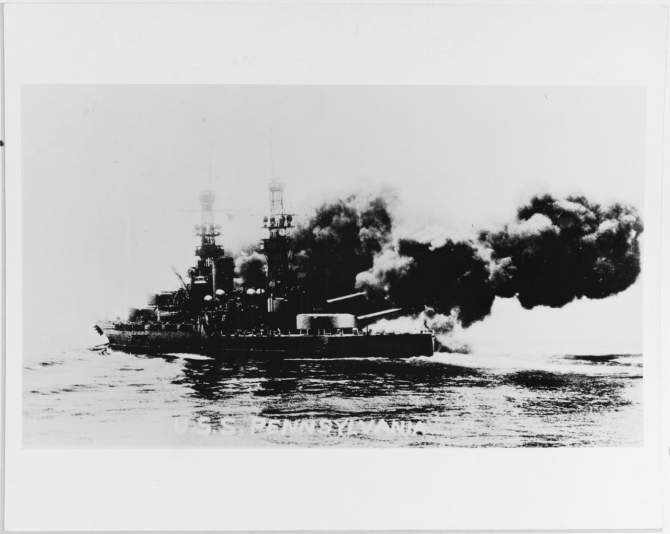
Pennsylvania firing a 14-inch broadside, during the early 1920s. Courtesy of Mrs. D.M. Corn, Las Cruces, New Mexico. (Naval History and Heritage Command Photograph NH 78908)
Having spent Christmas and New Year’s Day in port, Pennsylvania got underway on 19 January 1922. She spent most of the year cruising along the West Coast making port visits to San Francisco, Seattle, Wash., Port Angeles, Wash., and San Diego, Calif. During this time she also spent a period (6 March-19 April) undergoing maintenance at the Puget Sound Navy Yard. During the Gunnery Year 1922-23, Pennsylvania was awarded the Battle Efficiency Pennant for her performance during the annual gunnery exercises. On 18 December, she entered the Puget Sound Navy Yard at Bremerton and remained there into 1923.
Pennsylvania got underway from Bremerton on 28 January 1923 bound for San Diego via San Francisco. She reached her destination on 2 February. The next day she returned to San Pedro and remained there until 8 February, when she departed bound for Panama. After transiting the Panama Canal, she steamed into the Caribbean for a visit to Culebra, Puerto Rico. In short order, she returned to the Canal Zone and passed back through the Canal to Balboa. She remained for a period in Panama before returning to San Pedro on 13 April. After a month and a half in port, Pennsylvania got underway on 28 May, for San Francisco via Monterey, Calif., and arrived on 31 May. While at San Francisco, she went into the yard at Hunter’s Point until 2 July. Afterward, she spent the next five months steaming along the West Coast and calling at various ports in California and Washington. She was underway conducting fleet training from 27 November through 7 December, and on 17 December, was en route to Puget Sound Navy Yard, for overhaul. She arrived at Bremerton on 22 December, and underwent maintenance into the new year.
With her yard work completed Pennsylvania departed on 1 March 1924, and arrived at San Francisco, two days later. After receiving ammunition, she moved on to San Diego, Calif., and joined the Battle Fleet on 9 March. The fleet moved on to the Gulf of Fonseca, Nicaragua, where it remained (16-17 March) before shifting to Balboa. Standing there from 20-24 March, Pennsylvania transited the Panama Canal into Limon Bay on 24 March and on 28 March; she arrived at Vasquez Sound, U.S. Virgin Islands. She then moved to Puerto Rico and departed for the Canal Zone on 1 April, returning through the Panama Canal to Balboa on 5 April. After a week, Pennsylvania departed for San Pedro on 12 April. Conducting tactical exercises enroute, she arrived at her homeport on 22 April.
Pennsylvania, on 25 June 1924, got underway bound for the Pacific Northwest coast, reaching Seattle, Wash., on 30 June. As the flagship of Battle Division 3, Battle Fleet, Pennsylvania conducted divisional tactical exercises and ship and gunnery drills off the Washington coast until she departed Seattle on 1 September. The ship arrived at San Francisco on 4 September and remained there until 8 September. Through much of the remainder of the month, Pennsylvania was at sea, conducting fleet tactical exercises and gunnery training (12-22 September) and a joint exercise with the Battle Fleet and the San Francisco coastal defenses (26-29 September). Arriving back at San Pedro on 1 October, the ship underwent machinery overhaul at anchor twice into the new year (1-13 October and 13 December-5 January 1925).
On 21 January 1925, she got underway for the Puget Sound Navy Yard. Arriving on 25 January, she underwent overhaul until 24 March. Upon completion, she weighed anchor to return home and arrived at San Pedro on 27 March. Enroute to San Francisco on 3 April, she arrived on 5 April and then departed with the fleet, on 15 April 1925. After war games in the Hawaiian area, the fleet departed Honolulu (H.T), on 1 July, enroute to Melbourne, Australia, reaching on 22 July. She departed on 6 August for a port visit to Wellington, New Zealand, arriving on 11 August. She then weighed anchor for home on 22 August, and after calling at Pago Pago, Samoa and Hilo, H.T. returned to San Pedro, Calif., on 26 September 1925. After a time in port, Pennsylvania shifted to San Diego to conduct battle target practice (5-8 October). Afterward, she returned to base and did not get underway for a major exercise for the remainder of 1925.
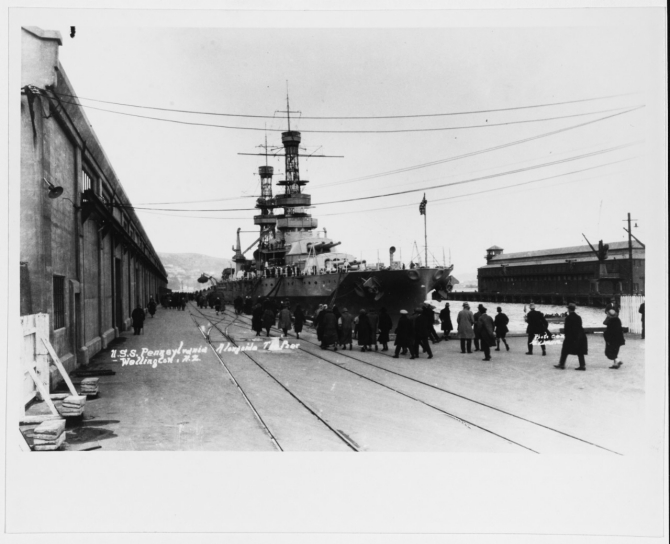
Pennsylvania at Wellington, New Zealand, during the U.S. Fleet's trans-Pacific cruise, 11 August 1925. Photo by Al Lamarre. Collection of Cmdr. Haines H. Lippincott, USN (Chaplain Corps). (Naval History and Heritage Command Photograph NH 92835)
On 1 February 1926, Pennsylvania departed San Pedro with the Battle Fleet bound for Balboa to conduct tactical training (15-27 February) and upon completion returned to San Diego. Departing on 7 March for San Francisco, she arrived on 8 March, and remained there until 12 March. She then weighed anchor bound for Puget Sound Navy Yard and arrived on 15 March for a two-month overhaul. With the maintenance completed, she departed Bremerton on 14 May, bound for her homeport, reaching on 18 May. She got underway on 16 June for port visits to San Francisco (18-21 June), Tacoma, Wash. (27 June-6 July). Through the next few weeks, she operated in the waters off the Pacific Northwest while also making visits to Port Angeles, Wash., Bellingham, Wash., and Seattle Wash. She then departed for San Pedro via San Francisco on 16 August, arriving at her homeport on 1 September.
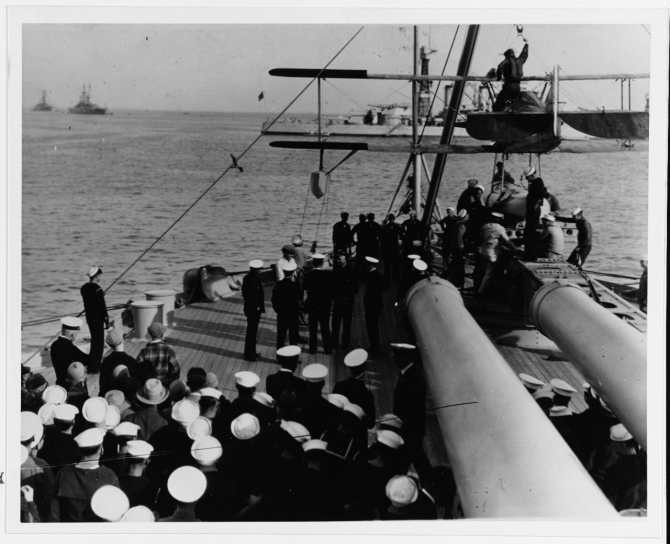
American humorist Will Rogers (hatless, in center) talks with some of the ship's officers on the quarterdeck, on board Pennsylvania, March 1928. Note men at right placing a Vought UO-1 aircraft on the catapult. Courtesy of the Naval Historical Foundation, Collection of Adm. Montgomery M. Taylor. (Naval History and Heritage Command Photograph NH 42749)
Pennsylvania stood at San Pedro from 11 December 1926 through 11 January 1927, when she departed bound for Bremerton and maintenance at the Puget Sound Navy Yard. On 12 March, she set a course for San Francisco, reaching on 15 March. That same day, she moved on to San Pedro, arriving the 16th. Pennsylvania stood out of San Pedro on 17 March, bound for Balboa, Panama via San Diego. Arriving at Balboa on 29 March, the battleship transited the Panama Canal to Colon, on 31 March before heading to Guantanamo Bay, arriving in Cuba on 4 April for gunnery exercises. During the competitions for Gunnery Year 1926-27, Pennsylvania rated fourth in the Short-Range Battle Practice, but only 14th in the Force Battle Practice. Her final standing was fifth out of the fifteen battleships that fired that year.
After completing the target practices, she got underway for Gonaïves, Haiti on 18 April 1927. Arriving on 22 April, she remained a short time before departing bound that same day for New York. Pennsylvania stood into New York on 29 April and remained there until 16 May, when she got underway for Newport. After a week-long port visit, she set a course for Hampton Roads on 28 May and arrived the next day. Pennsylvania then weighed anchor for Colon reaching on 11 June. The next day, she passed through the Panama Canal back to the Pacific. After staying at Balboa until 17 June, she got underway for San Pedro, 28 June. Through the remainder of 1927, Pennsylvania conducted training, maintenance, and port visits along the Pacific coast.
Pennsylvania’s overall standing in gunnery fell to 12th during the competition for Gunnery Year 1927-28. While her Short-Range Battle Practice scored fifth, her last-place score (16th) in the Long-Range Battle Practice negatively affected her overall standing. She arrived at the Puget Sound Navy Yard on 1 April 1928 and underwent a period of maintenance until 16 May, when she got underway enroute to San Francisco. Arriving there on 19 May, Pennsylvania departed the same day to return to the Pacific Northwest, this time bound for Victoria, British Columbia (B.C.). Reaching on 24 May, she remained there until the 28th, when she weighed to return to San Francisco. While enroute, she pulled into Bolinas Bay, Calif., on 31 May. Getting underway on 2 June, she reached San Francisco the same day, after a short voyage. Two days later, 4 June, she departed for Seattle via Presidio Shoals, Calif., and reached her destination on 8 June. Pennsylvania then spent the remainder of the month shuttling between Seattle, San Francisco, Victoria, and Vancouver (B.C.). Pennsylvania, on 7 August 1928, embarked Secretary of War Dwight F. Davis at San Francisco. Departing the same day, she arrived at Honolulu on 13 August. She then returned to Seattle on 26 August.
In January 1929, Pennsylvania cruised to Panama and after training maneuvers while based at Guantanamo Bay, she steamed to the Philadelphia Navy Yard, arriving on 1 June 1929 to undergo overhaul and modernization. Placed in reduced commission, she remained in the yard for nearly two years. During that modification the ship received additional deck and turret top armor along with a “torpedo bulge” on each side which broadened her beam to 106'3", the maximum allowable for passage through the locks of the Panama Canal. In addition to new turbo-generators, the installation of six new three-drum boilers and newer turbines upgraded the ship’s power plant. The ship’s main battery saw an increase in elevation to 30 degrees and her secondary battery was reduced to twelve 5-inch/51 caliber guns. The 3-inch antiaircraft guns were also replaced by eight 5-inch/25 caliber guns and her torpedo tubes removed. Tripod masts mounting the fire-control installations and fighting tops replaced the lattice masts. The ship’s bridge was enlarged and modernized to reflect her role as a fleet flagship and her crew space increased to allow for 2,037 sailors and marines. Pennsylvania also received two catapults for aircraft.
Pennsylvania returned to full commission on 1 March 1931, Capt. John M. Enochs in command. After trials off Delaware Bay during March and April, she departed for a refresher training cruise to Guantanamo Bay on 8 May, and returning to Philadelphia via Hampton Roads on 26 May. She again sailed for Guantanamo via Hampton Roads on 30 July and reached Cuba on 5 August. She passed through the Panama Canal on 12 August and made her return to San Pedro, where she rejoined the Battle Fleet on 27 August. Afterward, she remained in port through the end of the year.
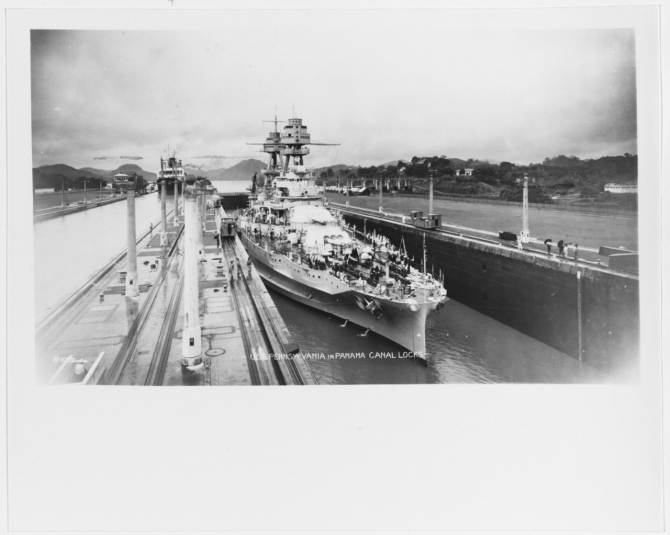
Pennsylvania in the Miraflores Locks, Panama Canal, circa 1931-32. Collection of ADJC Francis Brannigan, USN Ret., 1982. (Naval History and Heritage Command Photograph NH 93734)
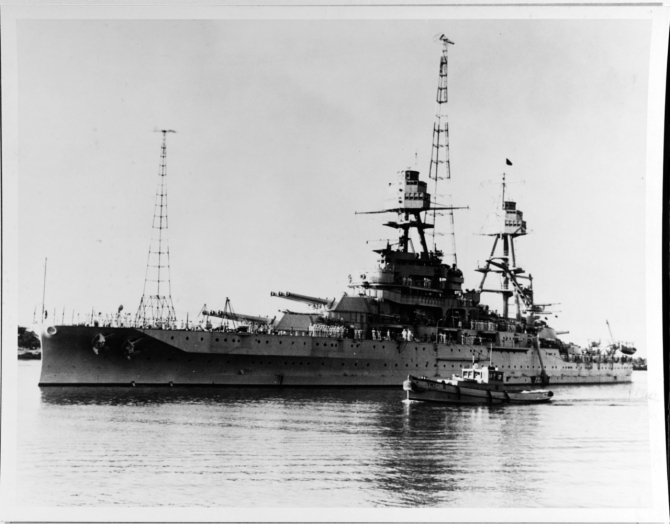
Pennsylvania, Flagship, U.S. Fleet, Adm. Frank H. Schofield, at Pearl Harbor, Territory of Hawaii, 3 February 1932. (Naval History and Heritage Command Photograph NH 67633)
After spending much of January 1932 cruising on the West Coast, Pennsylvania departed San Pedro on 26 January and arrived at Pearl Harbor, T.H. on 3 February. In preparation for the upcoming fleet problem she maneuvered in Hawaiian waters calling at Hilo and Lahaina Roads in February. During Fleet Problem XIII, 8-18 March 1932, Pennsylvania served as the “Blue Fleet” flagship. During the simulated action of the war games on 16 March, the flagship was seriously damaged by air and surface attack from the “Black” forces and reduced to 20 percent effectiveness by bombers launched from Lexington (CV-2). The total damage to the “Blue” forces from combined “Black” air and surface action saw one carrier, one light cruiser, and one destroyer “sunk” and three battleships and five destroyers “damaged”. At the completion of the exercise, Pennsylvania returned to San Pedro, reaching on 20 March. She would remain at her homeport until 18 April, when she got underway to resume cruising along the California coast making periodic port visits to San Francisco and San Diego into the Fall. She returned to San Pedro on 14 November and stood in port through year’s end.
Pennsylvania began 1933 still at San Pedro. She got underway on 9 February to participate in Fleet Problem XIV (10-17 February 1933). During this exercise, Pennsylvania again served as the “Blue” flagship. On 16 February, the battleship was spotted along with Milwaukee (CL-5) by aircraft from Saratoga (CV-3). As Saratoga recovered her aircraft her “Black” cruiser escorts engaged Milwaukee and leaving her in a sinking condition. Pennsylvania soon came up with additional warships. The “Black” force moved to disengage and, with their higher speed, largely succeeded though Saratoga was attacked by land-based dive bombers which followed the carrier’s returning aircraft to the target. In the course of the day’s action, the umpires assessed Pennsylvania as having sustained 14 percent damage. At the completion of the fleet problem, she moved on and stood into San Francisco on 17 February. Remaining there until 27 February, she weighed anchor for San Pedro, arriving the next day. The ship would remain at the San Pedro anchorage until 19 June. After getting underway that day, Pennsylvania spent the following months steaming along the Pacific coast conducting training and making periodic port visits. Pennsylvania returned to San Pedro on 14 November, and remained in port well into 1934.
After over four months, Pennsylvania got underway for Hunter’s Point on 4 March 1934. Arriving on 5 March, she remained until 8 March, when she departed to return to San Pedro, reaching the next day. She then weighed anchor on 9 April bound for Balboa. Reaching on 24 April, Pennsylvania transited the Panama Canal to Cristobal, C.Z. the same day.
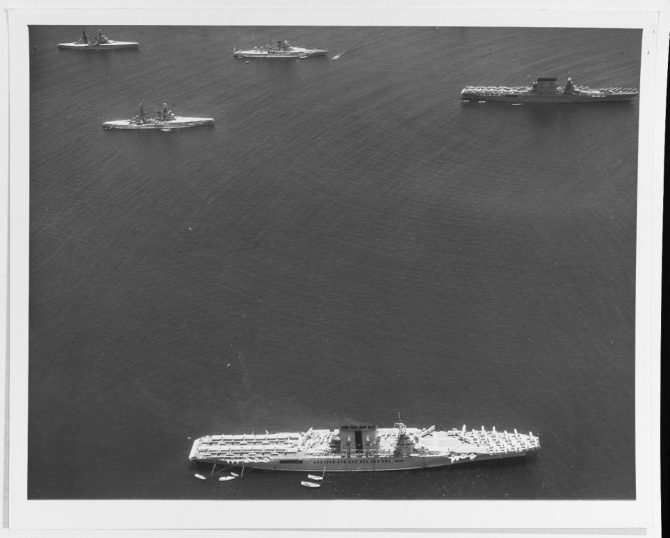
Pennsylvania flagship--and two other battleships of the U.S. Fleet with Saratoga (CV-3), Lexington (CV-2) anchored off Colon, Canal Zone, 27 April 1934, during the fleet's annual inter-ocean movement. (U.S. Navy Photograph 80-G-455927, National Archives and Records Administration Still Pictures Division, College Park, Md.)
She departed Cristobal to participate in Fleet Problem XV (19 April to 12 May 1934) which took place in the waters off Panama and into the Caribbean. The “Blue” Fleet was commanded by Adm. Joseph M. Reeves, with Pennsylvania serving as his flagship. The problem consisted of three sequential exercises that envisioned different segments of an ongoing naval campaign against a “Gray” force threatening the Caribbean in union with an allied “Brown” force. Upon the completion of the exercises, the fleet stood in Gonaïves Bay, until 25 May when it departed for New York, arriving on 31 March. That same day, off the Ambrose Channel Lightship, Pennsylvania led Lexington and Saratoga; the battle line; and a series of lesser ships in review past President Franklin D. Roosevelt, on board Indianapolis (CA-35). Then with Indianapolis leading, the fleet steamed into New York Harbor to anchor in the North River. Just over two weeks later on 15 June, Adm. Reeves relieved Adm. David F. Sellers as Commander in Chief, U.S. Fleet (CINCUS) in a change-of-command ceremony on board Pennsylvania.
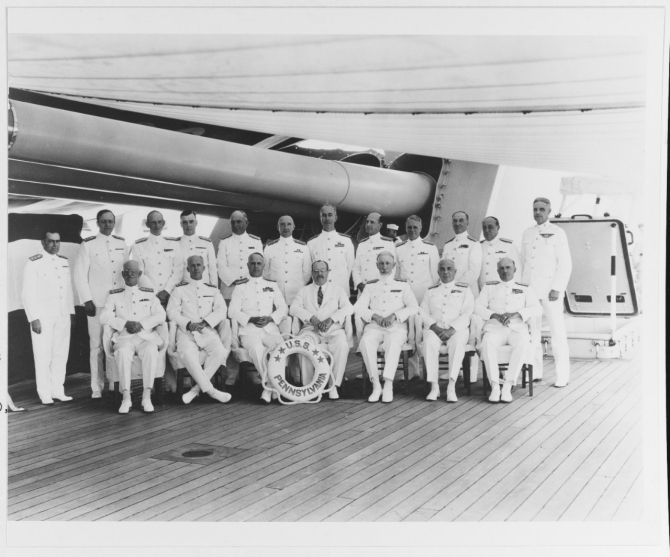
Assistant Secretary of the Navy Henry L. Roosevelt (seated, right center), and Adm. David F. Sellers, Commander in Chief, U.S. Fleet (seated, left center), with other U.S. Fleet flag officers on board Pennsylvania, Spring 1934. Courtesy of Rear Adm. Charles H. Lyman, USN (Ret.), 1972. (Naval History and Heritage Command Photograph NH 76413)
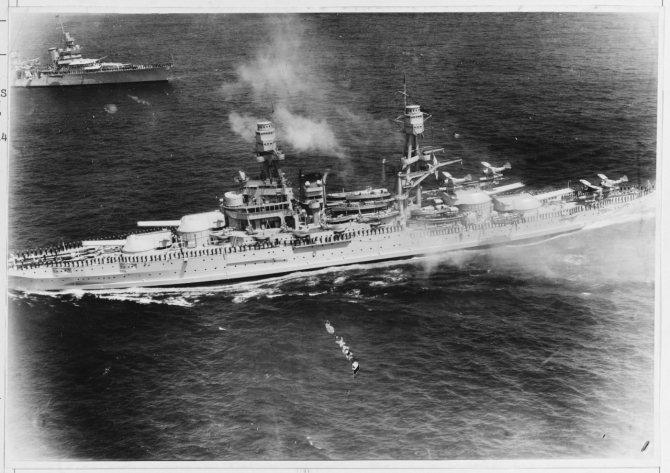
Pennsylvania, foreground, and Indianapolis (CA-35) as seen from the air, salute President Franklin D. Roosevelt during the fleet review of 31 May 1934. (Naval History and Heritage Command Photograph NH 686)
Pennsylvania remained at New York until 18 June 1934. Bound for Hampton Roads, she arrived on 20 June, enroute to Cristobal. She reached the Canal Zone on the 28th, transited to Balboa that same day, and ultimately arrived at San Pedro on 7 July. After only a stay of two days, Pennsylvania got underway for the Puget Sound Navy Yard. Arriving on 14 July, she underwent a maintenance period until 2 October when she underwent a one-day trial. She finally departed Bremerton on 16 October and arrived at San Francisco on the 18th. Pennsylvania then made turns and got underway on 29 October for San Pedro, via Santa Barbara, Calif., returning to her homeport on 2 November. Through the next seven weeks, she shuttled between San Pedro and San Francisco conducting trials and training. Pennsylvania returned to San Pedro on 21 December and remained through the end of 1934.
On 11 February 1935, Pennsylvania got underway and shuttled to San Francisco, returning on the 14th. From 29 April through 10 June 1935, the Navy held Fleet Problem XVI. Strategic in scope, this exercise was the largest to date in the Pacific and pitted a “Black” force notionally operating from the Aleutian Islands against a “White” force operating from Hawaii and the west coast. Based at San Pedro, Pennsylvania participated in the exercise as part of the “White” force. Upon completing the exercise, the battleship returned from Hawaii via San Diego, reaching San Pedro on 17 June.
Having spent the months since the fleet problem cruising off the west coast, Pennsylvania departed San Pedro on 16 December, for Puget Sound Navy Yard. Arriving on 20 December, she entered the yard for a maintenance period that carried into 1936. Also during 1935, in a battle of a different kind, Pennsylvania’s football team captured the Fleet Championship and held it through 1937.
After a one-day trial on 13 March 1936, Pennsylvania completed her yard period on 21 March Bound for San Pedro, she returned to her homeport on the 25th. After a month in port, she departed San Pedro on a heading to Balboa in order to participate in Fleet Problem XVII (27 April-7 June). Upon completing her role in the exercise, Pennsylvania returned to San Pedro on 6 June. She remained there until 30 June, when she got underway. After visiting San Francisco, she spent the Summer and Fall conducting training and exercises on the West Coast and in Hawaiian waters. She returned to San Pedro on 18 November and completed operations underway for the calendar year.
Pennsylvania was still in port on New Year’s Day 1937. She would not get underway again until departing, bound for San Clemente, Calif., on 17 February. As in previous years, she steamed along the West Coast and participated in the annual fleet problem in Hawaiian waters (Fleet Problem XVII, 16 April-28 May) through the first half of 1937. She went into the yard at Puget Sound for maintenance on 6 June. Leaving on 3 September, Pennsylvania made her way south along the West Coast and arrived back at San Pedro on 8 September. The battleship remained in port until getting underway for San Francisco on 8 November. Arriving the next day, she stayed a week before departing on the 15th, and anchoring at San Pedro on 19 November, ending her time underway for 1937. She spent the balance of the year in port.
Pennsylvania got underway on 12 February for the first time in 1938, when she stood out of San Pedro bound for San Francisco. Arriving the next day, she remained until the 18th and returned to San Pedro one day later. Fleet Problem XIX took place from 9 March to 30 April. The initial part of the exercise was a Communications Mobilization and Fleet Sortie (9-15 March) which saw Pennsylvania depart San Pedro on 15 March to participate in the multiple stage exercise. She steamed to sea conducting tactical training en route. As part of the Replenishment and Reorganization Phase (30 March-4 April), she arrived in the Hawaiian area on the 31st. In subsequent days, Pennsylvania participated in various exercises until the entire U.S. Fleet conducted a port visit to Pearl Harbor for replenishment, rest, and liberty from 8-18 April. Pennsylvania put to sea on 21 April, departing Hawaiian waters she participated in maneuvers that consisted of notional defense of the West Coast (25-28 April) by the “Green” force against an attack from the “Purple” force. With the fleet problem completed, Pennsylvania returned to San Pedro on 30 April and remained there until 20 June. Departing San Pedro that day, Pennsylvania spent much of the next two months cruising the waters along the West Coast. She went into the yard at Puget Sound on 28 September. Remaining there until 16 December, she returned to San Pedro via San Francisco (19-20 December) on the 22nd.
Pennsylvania got underway bound for the Canal Zone on 4 January 1939. Arriving on the 13th, she transited the Panama Canal on 19 January enroute to Guantanamo Bay and the Caribbean for participation in Fleet Problem XX (20-27 February 1939). Pennsylvania’s participation in this fleet problem was noteworthy because President Roosevelt made a well-publicized appearance at the exercises, arriving on board the cruiser Houston (CA-30) which served as the flagship for CINCUS, Adm. Claude C. Bloch. The President along with Adm. William D. Leahy, the CNO, transferred to Pennsylvania, the fleet flagship for the “White” forces, to observe the first part of the problem. After two days he returned to Houston, which was serving as part of the “Black” forces to observe the remainder of the maneuvers, a set-piece tactical exercise. With the completion of the exercise, Pennsylvania stood at Culebra on 27 February. She departed on 4 March and shifted to Port-au-Prince, for a port visit (6-11 March). Afterward, she spent time at Guantanamo (12-31 March), then set a course for the U.S. Naval Academy at Annapolis, Md., reaching on 5 April. Pennsylvania departed on 18 April for a return to the Pacific. She made a one-day port visit at Norfolk (19-20 April) enroute to the Canal Zone, and arrived on the 26th. Having transited the Panama Canal, she departed the Canal Zone on 2 May and returned to San Pedro on the 12th. After a time in port, Pennsylvania spent the latter part of the year, steaming along the West Coast, conducting training and making port visits to San Francisco, Tacoma, and Seattle before returning to San Pedro on 20 October.
After almost six months in port, Pennsylvania got underway bound for Lahaina Roads and Fleet Problem XXI, on 2 April 1940. During the exercises, which ended on 17 May, CINCUS Adm. James O. Richardson discussed the plans for the maneuvers with Adm. Charles P. Snyder, Commander Battle Force, U.S. Fleet and Vice Adm. William S. Pye, Commander Battleships, Battle Force, U.S. Fleet while on board the battleship. The ship remained in Hawaiian waters and did not depart for a return to San Pedro until 1 September. Arriving on 7 September, she stood in port until the 12th, when she got underway for a yard period at Puget Sound. Arriving on the 16th, Pennsylvania underwent overhaul until 27 December, when she departed for San Pedro, arriving on New Year’s Eve.
Though scheduled for January 1941, Fleet Problem XXII was cancelled as a result of the outbreak and widening of the war in Europe. On 7 January 1941, Pennsylvania sailed for Hawaii, arriving on the 14th. As part of the Pacific Fleet, formally recreated on 1 February 1941 and now based at Pearl Harbor, she spent most of the year carrying out scheduled operations with units of Task Forces 1 and 5, including making one brief voyage to the West Coast with Task Force 18 (12 September-11 October).
At the time of the Japanese attack on Pearl Harbor, 7 December 1941, Pennsylvania lay in Dry Dock No.1 in the Pearl Harbor Navy Yard, with three of her four propeller shafts removed, with the destroyers Cassin (DD-372) and Downes (DD-375), just forward. The new Dry Dock No. 2 lay unoccupied. When it was realized that the base was under attack, men proceeded to their stations and “air defense” was sounded, followed shortly thereafter by general quarters. Between 0802 and 0805, Pennsylvania commenced firing at the attacking planes, within short order all antiaircraft batteries were brought into action. Shaw (DD-373), in the floating dry dock YFD-2 on the opposite side of Dry Dock No.2, was hit by a bomb and set afire. The Japanese bombers and torpedo planes did not succeed in repeated attempts to torpedo the caisson of the drydock, but Pennsylvania and the surrounding dock areas were severely strafed. Between 0830 and 0915, the Japanese carried out five high-altitude bombing attacks (between 10,000 and 12,000 feet), one from the port bow, one from ahead, one from ahead passing to starboard, and two from astern, passing over Pennsylvania. The second attack coming in slightly on the port bow dropped bombs on the ships in the drydock at 0906. One heavy bomb hit Downes, one hit the dock approximately abreast frame 20 starboard of Pennsylvania, and one hit the boat deck of the battleship a few feet abaft 5-inch/51 gun No. 7, passing through the boat deck and detonating inside casemate No. 9. The third bombing attack from ahead, appeared to drop bombs shortly after passing overhead on battleships across the channel. All of those high-altitude attacks were fired upon by the ship’s batteries, but it appears that the fuse settings were too short and did not reach the bombers. Sporadic attacks continued for an additional fifteen minutes during which a low-flying aircraft on a strafing run was taken under heavy fire and shot down, crashing onto the hospital grounds. A total of six downed aircraft were claimed in the aftermath of the raid, but the after-action report noted that only two had “fairly good proof of having been hit by the ship…”
The flooding of the drydock began at 0920. Both destroyers ahead of Pennsylvania were on fire, setting the paint on the battleship’s starboard bow alight. Around 0930, explosions on the destroyers began to take place and at 0941 ammunition on Downes exploded on the starboard side, covering the area with debris. A section of a torpedo tube, weighing between 500 and 1,000 pounds, was blown onto Pennsylvania’s forecastle. Measures were taken to ensure that fires in the forward part of the battleship did not spread out of control. In short order the crew, utilizing the ship’s motor launches, took action to replenish her ammunition from West Loch and by 1400, preparatory work for repairing the bomb damage began. The damaged West Virginia provided Pennsylvania’s ship’s force with a 5-inch/25 antiaircraft gun and a 5-inch/51 broadside mount to replace the ones damaged in the attack.
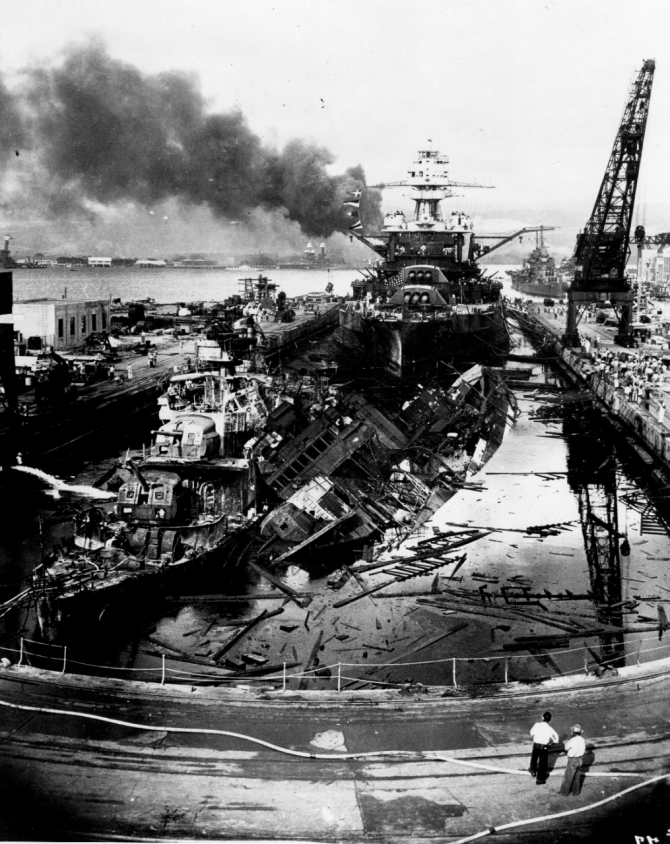
The wrecked destroyers Downes (DD-375) and Cassin (DD-372) in Dry Dock No. 1 at the Pearl Harbor Navy Yard, soon after the end of the Japanese air attack. Cassin has rolled off her blocks onto her sistership Downes. Pennsylvania lies astern, occupying the rest of the dry dock. The torpedo-damaged cruiser Helena (CL-50) is in the right distance, beyond the crane. Visible in the center distance lies the capsized Oklahoma (BB-37), with Maryland (BB-46) alongside. Smoke is from the sunken and burning Arizona (BB-39), out of view behind Pennsylvania. California (BB-44) is partially visible at the extreme left. This image has been attributed to Photographer's Mate Harold Fawcett. (U.S. Navy Photograph 80-G-19943, National Archives and Records Administration, Still Pictures Division, College Park, Md.)
Less than a week after being damaged in the Japanese attack, Pennsylvania undocked on 12 December 1941, and was ready to go to sea despite not having No. 9 5-inch/51 gun ready. On 20 December, she sailed for San Francisco, arriving on the 29th.
Pennsylvania entered dry dock at Hunter’s Point on 1 January 1942 and underwent repairs. Undocking on 12 January, she departed San Francisco for practice firing on 20 February, returning the next day. She again departed San Francisco on 19 March for practice firing and returned on the 23rd. From 14 April to 1 August 1942, Pennsylvania conducted extensive training operations and patrols along the coast of California, intervened by overhaul at San Francisco.
During that duty, on 4 June 1942 (the opening day of the Battle of Midway), Adm. Ernest J. King, ComInCh, held brief ceremonies on board Pennsylvania to present the Distinguished Service Medal to Adm. Chester W. Nimitz for exceptionally meritorious service as Commander in Chief of the U.S. Pacific Fleet since 31 December 1941. Soon thereafter, Pennsylvania put to sea with Task Force 1 (5-19 June) (Vice Adm. William S. Pye in command) to operate in support of the ongoing operations in the Battle of Midway, with air cover provided by the aircraft escort vessel Long Island (AVG-1).
Pennsylvania departed San Francisco on 1 August 1942 for Pearl Harbor, arriving on 14 August. She conducted gunnery exercises and took part in carrier task force guard tactics in the Hawaiian area. On 4 October, Pennsylvania returned to San Francisco, for overhaul and modernization at the Bethlehem Steel Co. yard.
Pennsylvania entered the dry dock at Hunter’s Point on 3 January 1943, undocking on 10 January. She then departed San Francisco on 24 January for a trial run and test firing, returning that same day. Pennsylvania remained until 6 February, when she stood out of San Francisco bound for Long Beach, Calif., arriving the next day. Based at Long Beach, the battleship conducted refresher training and air defense patrols and undertook a series of battle practices into April, in preparation for combat operations. On 23 April, Pennsylvania sailed for Alaska to take part in the Aleutian Campaign.
Pennsylvania arrived at Cold Bay, Alaskan Territory on 30 April 1943. During 11-12 May, she bombarded Holtz Bay and Chicagof Harbor, Attu, in support of the landings. As Pennsylvania retired from Attu on 12 May, a Consolidated PBY Catalina warned that a torpedo wake was headed for her. She maneuvered at full speed as the torpedo passed astern. The destroyer Edwards (DD-619) teamed with Farragut (DD-348) to hunt down the attacker. After ten hours of relentless depth charge attacks, submarine I-31 (Cmdr. Inoue Norikane, commanding) was forced to the surface and was shelled by Edwards. Severely damaged, the enemy survived until 13 June, then being sunk by the destroyer Frazier (DD-607). Torpedo wakes were again sighted, the morning of 14 May, and destroyers conducted a fruitless search for the enemy. That same morning, Pennsylvania launched her float planes to operate from the seaplane tender Casco (AVP-12) in making strafing attacks on enemy positions on Attu.
The afternoon of 14 May 1943, Pennsylvania conducted her third bombardment mission, this time in support of the infantry attack on the west arm of Holtz Bay. She then operated to the north and east of Attu until 19 May, when she set course for Adak. Soon afterwards, an explosion occurred in her gasoline stowage compartment, causing structural damage but no casualties. She departed Adak on 21 May, and arrived at the Puget Sound Navy Yard one week later, on the 28th. She entered dry dock on 31 May and underwent an overhaul, during which time (2 June) the ship experienced a second gasoline explosion that killed one sailor and injured another. She undocked on 15 June and with her maintenance availability completed, departed Bremerton on 1 August. She returned to Adak on 7 August, and departed on the 13th as the flagship of Adm. Francis W. Rockwell, commanding the Kiska Attack Force.
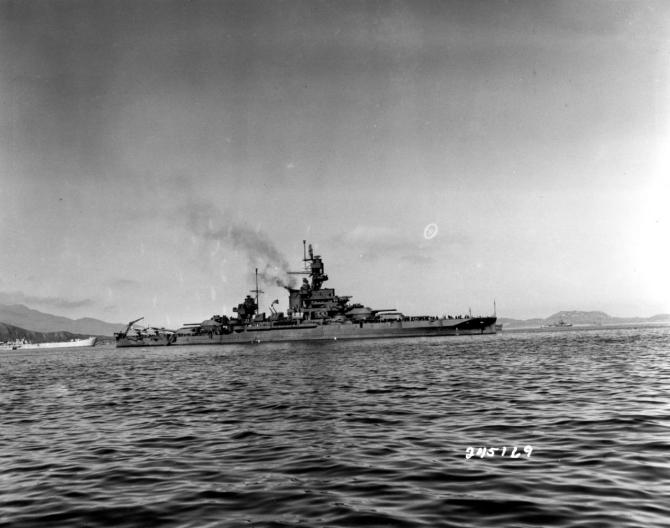
Pennsylvania in Adak Bay, Adak, Aleutian Islands, Alaskan Territory, 12 August 1943, just prior to the Kiska operation. An LST is in the left background. (U.S. Army Signal Corps Photograph SC-245169, National Archives and Records Administration, Still Pictures Division, College Park, Md.)
On 15 August 1943, assault troops landed without opposition on the western beaches of Kiska. By the evening of 16 August, it became apparent that the Japanese had evacuated under cover of fog prior to the landing. She patrolled off Kiska for a time then returned to Adak on 23 August.
Pennsylvania set course for Pearl Harbor on 25 August 1943, arriving on 1 September. There she embarked 790 passengers and departed on 19 September for San Francisco, where she arrived on 25 September. After debarking her passengers, she returned to Pearl Harbor on 6 October and took part in rehearsal and bombardment exercises in the Hawaiian areas (20-23 October and 31 October-4 November). She became the flagship for Rear Adm. Richmond K. Turner, Commander Fifth Amphibious Force, and formed part of the Northern Attack Force departing Pearl Harbor on 10 November for the assault on Makin Atoll, Gilbert Islands.
The task force, comprising four battleships, four cruisers, three escort carriers, transports and destroyers, approached Makin from the southeast on the morning of 20 November 1943. Pennsylvania opened fire on Butaritari Island with her main battery at the initial range of 14,200 yards and then unleashed her secondary battery. Just before general quarters on the morning of 24 November, a tremendous explosion took place off the starboard bow as Pennsylvania was returning to a screening sector off Makin. At almost the same instant an accompanying destroyer reported a sound contact near the disposition and immediately executed a course change. For several minutes after the explosion, a large fire illuminated the area. Word soon came that escort carrier Liscome Bay (CVE-56) had been torpedoed, and she sank with tremendous loss of life. Japanese torpedo planes conducted determined night air attacks 25 and 26 November, but the task force repelled them without damage to itself. On 30 November, Pennsylvania departed the Makin area for Pearl Harbor.
On 1 January 1944, Pennsylvania lay at Pearl Harbor. During the ensuing few weeks, she twice conducted training exercises (3-5 January and 12-17 January) in preparation for the assault on Kwajalein, Marshall Islands. Departing Pearl Harbor on 22 January, she commenced her bombardment of Kwajalein Island on 31 January, which continued throughout the day. Landings began on 1 February, with Pennsylvania joining in bombardment support before and after the landing operations. On the evening of 3 February, she anchored in the lagoon near Kwajalein Island. With the atoll secured, Pennsylvania retired to Majuro atoll to replenish ammunition. On 12 February, Pennsylvania got underway for operations against Eniwetok, Marshall Islands. She steamed boldly through the swept channel into Eniwetok lagoon on 17 February. Taking up a position off Engebi Island, she commenced bombarding the Japanese installations. On the morning of 18 February, Pennsylvania bombarded Engebi before and during the approach of the assault waves to the beach. When Engebi had been secured, Pennsylvania steamed southward through the lagoon toward Parry Island, where she took part in the bombardment on 20-21 February, preparing for the amphibious assaults. At the commencement of the bombardment, the island had been covered with a dense growth of palm trees extending to the water’s edge. At its conclusion, not a single tree remained standing. On the morning of 22 February, she provided bombardment support prior to the landing on Parry Island.
Pennsylvania retired to Majuro on 1 March 1944 and then steamed south to Havannah Harbor, Efate, New Hebrides [Vanuatu]. She remained at Efate until 24 April, when she departed bound for Sydney, Australia, arriving on 29 April. She returned to Efate on 11 May, then sailed to Port Purvis, Florida Islands, from which she operated to conduct bombardment and amphibious assault training exercises. Pennsylvania returned to Efate on 27 May, and after replenishing ammunition, departed on 2 June for Roi, where she arrived on 8 June.
Pennsylvania formed with a force of battleships, cruisers, escort carriers, and destroyers en route for the assault and occupation of the Marianas Islands on 10 June 1944. That night a destroyer in the screen reported a sound contact and an emergency 90 degree-turn left was ordered. As a result of that maneuver, Pennsylvania collided with the high speed transport Talbot (APD-7) and sustained minor damage. Talbot put into Eniwetok for emergency repairs.
Pennsylvania took part in the bombardment of Saipan on 14 June 1944 preparatory to the assault landings made the next day while she cruised off the northeastern shore of Tinian, conducting heavy bombardment of that island to neutralize any enemy batteries which might have opened fire on the landing beaches of Saipan. On 16 June, she conducted bombardment of targets on Orote Point, Guam, then retired to cover the Saipan area. Pennsylvania departed the Marianas on 25 June, and after a brief stay at Eniwetok, departed on 9 July to resume support of the Marianas campaign.
From 12 through 14 July 1944, Pennsylvania conducted bombardment of Guam in preparation for the assault and landings on that island. On completion of firing the evening of 14 July, she returned to Saipan to replenish ammunition. She returned to Guam on 17 July, and delivered protective fire support to demolition parties. At the same time she continued deliberate fire on designated targets through 20 July.
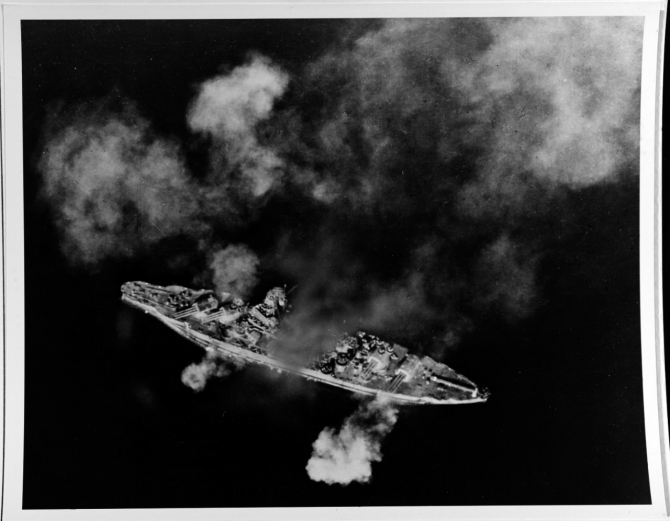
Pennsylvania firing her 14-inch/45 and 5-inch/38 guns while bombarding Guam, south of the Orote Peninsula, on the first day of landings, 21 July 1944. (Naval History and Heritage Command Photograph NH 67584)
In the early morning of 21 July 1944, Pennsylvania took a position between Agat Beach and Orote Peninsula, and commenced bombardment of beach areas in immediate preparation for the assault as troops and equipment were loaded into landing craft and landing waves formed. Upon establishment of the beachhead, she stood by to fire naval gunfire support missions (NGFS) as might be called for by fire control parties ashore, continuing this duty until 3 August. She then steamed to Eniwetok, arriving on 19 August and thence to the Pekoa Channel, Espiritu Santo, New Hebrides, arriving on 24 August. Departing on 27 August for assault landing rehearsals on Cape Esperance, Guadalcanal, Pennsylvania arrived at Port Purvis, Florida Island, on 29 August.
She departed on 6 September 1944, as part of the Palau Bombardment and Fire Support Group. From 12 through 14 September, Pennsylvania took part in the intensive bombardment of targets on the island of Peleliu. On 15 September, she also furnished gunfire support for the landings on that island. The battleship, on 17 September, moved on to Angaur Island and delivered a devastating fire on enemy gun emplacements among the rocks and cliffs flanking Red Beach. Departing Angaur on 20 September, Pennsylvania moved to the Kossol Passage Anchorage, Palau Islands, arriving the next day. After remaining for four days, Pennsylvania steamed for emergency repairs at Seeadler Harbor, Manus, Admiralty Islands, on 25 September. Arriving on 28 September, she entered the advanced base sectional dock ABSD-7 on 1 October 1944. With the repairs completed, she undocked on 8 October.
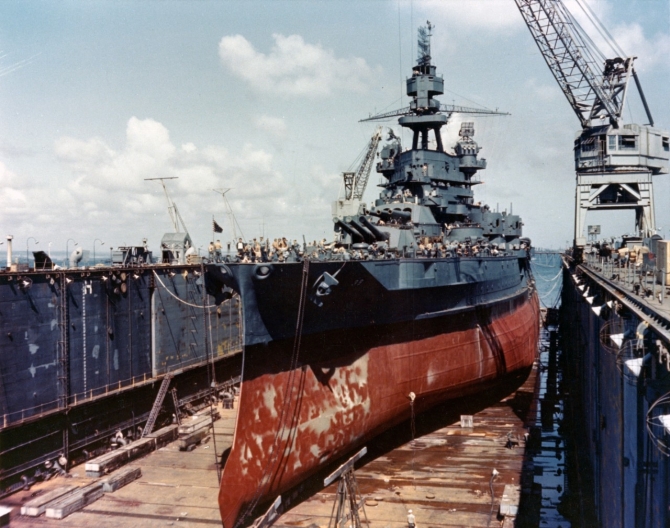
Pennsylvania drydocked in ABSD-7, October 1944. Note the extensive anti-torpedo blister built into her hull side and paravane streaming chains running from her forefoot to her foredeck. (U.S. Navy Photograph 80-G-K-2106, National Archives and Records Administration, Still Pictures Division, College Park, Md.)
Pennsylvania departed Manus on 12 October 1944, in company with battleships Mississippi (BB-41), Tennessee (BB-43), California (BB-44), Maryland (BB-46), and West Virginia (BB-48), as part of Rear Adm. Jesse B. Oldendorf’s Bombardment and Fire Support Group (Task Group 77.2) which constituted a part of the Central Philippine Attack Force under the command of Vice Adm. Thomas C. Kinkaid, Commander Seventh Fleet, en route to the Philippine Islands. She reached her fire support station on the eastern coast of Leyte, on 18 October, and commenced her covering bombardment for the beach reconnaissance, underwater demolition teams, and minesweeping units operating in Leyte Gulf and San Pedro Harbor. She conducted these bombardment missions the next day and supported the landings on Leyte on 20 October. Her NGFS missions, including harassing and night illumination fire, continued through 22 October.
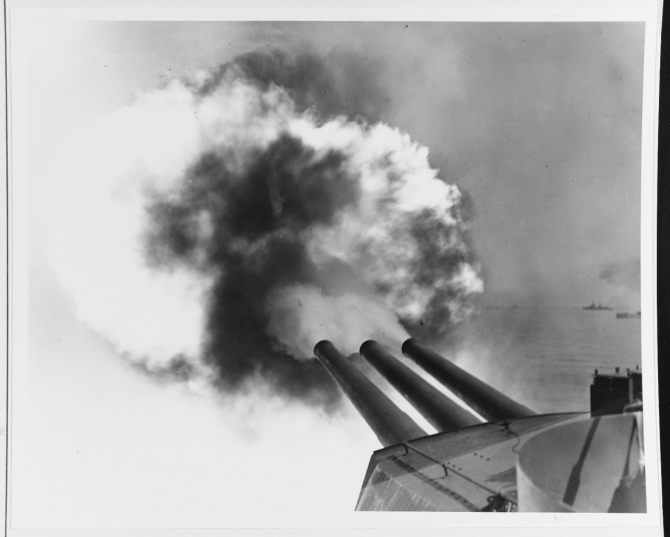
Pennsylvania’s 14-inch guns firing on Leyte on 20 October 1944. (U.S. Navy Photograph 80-G-288473, National Archives and Records Administration, Still Pictures Division, College Park, Md.)
On 24 October 1944, all available United States vessels prepared for action as units of the Imperial Japanese Navy closed with the Philippines, preliminary to the Battle for Leyte Gulf. Pennsylvania and five other battleships, with cruisers and destroyers of Rear Adm. Oldendorf's Force, steamed south and by nightfall were steaming slowly back and forth across the northern entrance of Surigao Strait, awaiting the approach of the enemy. That night, U.S. motor torpedo boats stationed well down in Surigao Strait made the first encounter with torpedo attacks. Destroyers of the force, on either flank of the enemy's line of approach, followed with torpedo and gun attacks. At 0353, 25 October, West Virginia opened fire, joined shortly thereafter by other battleships and cruisers. The Japanese Southern Force under Vice Adm. Nishimura Shoji had run head on into a trap as Rear Adm. Oldendorf crossed the "T." Using the superior radar fire control on three of the U.S. battleships which allowed firing from greater range and destroyers and PT boats for torpedo attacks, Oldendorf’s force ravaged the Japanese, who lost battleships Yamashiro and Fuso and three destroyers, Michisio, Asagumo, and Yamagumo, in the Battle of Surigao Strait. The heavy cruiser Mogami, in company with destroyer Shigure, all that remained of the enemy force, managed to escape. Rear Adm. Oldendorf's force did not suffer the loss of a single vessel. Mogami, further damaged that day by a collision with heavy cruiser Nachi and U.S. heavy cruiser gunfire, was crippled by carrier planes and eventually scuttled by destroyer Akebono. Interestingly, despite sounding general quarters at 0130, Pennsylvania was unable to find a target and her gun crews never received orders to commence firing; her guns remained silent through the entire action.
Ten enemy planes made a simultaneous run on a destroyer close aboard Pennsylvania which assisted in downing four and driving off the others on 25 October 1944. On the night of 28 October, she shot down a bomber as it attempted a torpedo run. Remaining on patrol in Leyte Gulf until 25 November, Pennsylvania then steamed to Manus, Admiralty Islands, arriving on 29 November. She then moved on to the Kossol Passage on 15 December, arriving on 18 December to replenish her ammunition, and on 22 December she conducted a practice firing, returning the same day.
Pennsylvania departed on 1 January 1945 with Vice Adm. Oldendorf's Lingayen Bombardment and Fire Support Group, steaming for Lingayen Gulf. The task group came under heavy air attacks on 4-5 January, with a kamikaze crashing the escort carrier Ommaney Bay (CVE-79) on the former day and damaging her irreparably, after which destroyer Burns (DD-588) scuttled her. Many other ships received damage on the 5th. On the morning of 6 January, Pennsylvania commenced bombardment of target areas on Santiago Island at the mouth of Lingayen Gulf. That afternoon, she entered the gulf to conduct counter-battery fire in support of minesweeping forces, retiring at night. At daybreak, on 7 January, the entire bombardment force entered Lingayen Gulf to deliver NGFS.
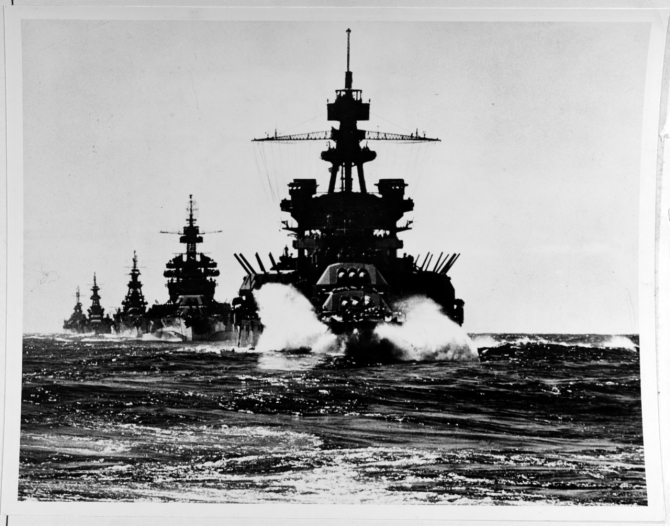
Pennsylvania followed by Colorado (BB-45) and the cruisers Louisville (CA-28), Portland (CA-33), and Columbia (CL-56) move in line into Lingayen Gulf preceding the landing on Luzon, 7-8 January 1945. (Naval History and Heritage Command Photograph NH 67432)
Preliminary assault bombardment was continued the next day. On 9 January 1945, Pennsylvania provided gunfire support for the protection of the waves of the landing troops from the U.S. Sixth Army under Lt. Gen. Walter Krueger. Japanese aircraft attacked the force in Lingayen Gulf on 10 January. Four bombs landed close by, but Pennsylvania received no hits. That afternoon, she executed her last fire support mission by firing twelve rounds to destroy a concentration of enemy tanks which had been located inland by a fire control party ashore.
From 10 to 17 January 1945, Pennsylvania patrolled in the South China Sea, off Lingayen Gulf, with other ships of the task group. On 17 January, she anchored in Lingayen Gulf, remaining until 10 February, when she sailed for temporary repairs at Manus. Departing on 22 February, she steamed via the Marshall Islands and Pearl Harbor to San Francisco, arriving on 13 March. She entered the Hunter's Point yard and underwent a thorough overhaul. Her main battery turrets and secondary battery mounts were re-gunned. Additional close range weapons as well as improved radar and fire control equipment were installed.
Upon completion of the overhaul, Pennsylvania conducted trial runs out of San Francisco, followed by refresher training while based at San Diego, Calif. She departed San Francisco on 12 July 1945 for Pearl Harbor, arriving six days later. After practice in Hawaiian waters (20-23 July), she returned to Pearl Harbor and then sailed for Okinawa on 24 July.
En route Pennsylvania took part in a bombardment of Wake Island on1 August 1945, during which time a shell fragment from a near-miss achieved by Japanese artillerists disabled one of the battleship’s 5-inch directors. Pennsylvania suffered no casualties, but one of the ship’s two Curtiss SC-1 Seahawks (BuNo. 35666) lost its right wing float during an attempted “Charlie” recovery in the heavy seas and capsized. The escorting destroyer Ordronaux (DD-617) rescued Lt. (j.g.) Gordon F. Gossman, the pilot, then sank the irreparable aircraft. After loading ammunition at Saipan the next day, Pennsylvania resumed her voyage to Okinawa, dropping anchor in Buckner Bay alongside Tennessee on 12 August.
That same day, however, a Japanese torpedo bomber slipped in over the bay undetected and launched a torpedo at Pennsylvania. Hit well aft, Pennsylvania suffered extensive damage. Twenty men were killed and ten injured. Many compartments were flooded and Pennsylvania settled heavily by the stern. Ship's repair parties brought the flooding under control with the prompt assistance of two salvage tugs. The following day, she was towed to more shallow water where salvage operations continued. Pennsylvania was the last major U.S. warship damaged in World War II. On 15 August, the ship received the news that the Japanese had surrendered
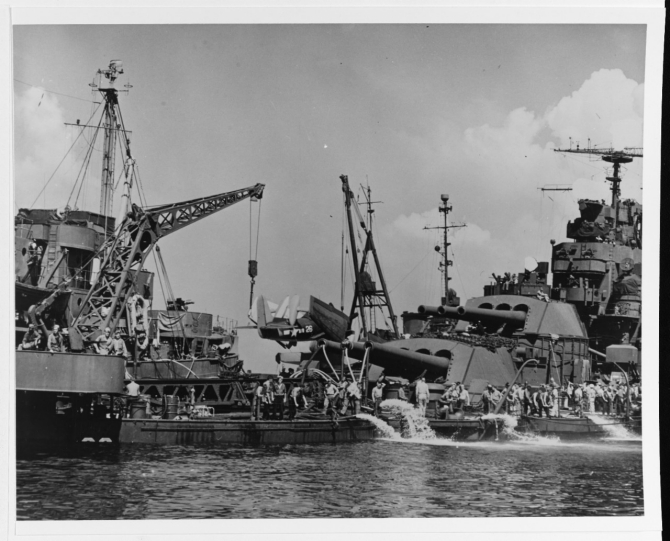
Pennsylvania low in the water and under salvage, after being torpedoed in Buckner Bay, Okinawa, 12 August 1945. A salvage tug is alongside, assisting. Note hoses run through her 14-inch/45 guns to help bring water from below decks. Note Curtiss SC-1 floatplane on her deck. The censors obliterated the ship’s radar antennas in this photo. (U.S. Navy Photograph 80-G-490327, National Archives and Records Administration, Still Pictures Division, College Park, Md.)
On 18 August 1945, Pennsylvania departed Buckner Bay under tow by two tugs. She arrived at Apra Harbor, Guam, on 6 September, and the next day, entered ABSD-3 where a large sheet steel patch was welded over the torpedo hole and repairs made to permit her to return to the U.S. under her own power. On 15 September, Missouri (BB-63) relieved Pennsylvania as fleet flagship. She undocked on 2 October, and two days later, on 4 October, she sailed for the Puget Sound Naval Shipyard in company with the destroyer Walke (DD-723) and the light cruiser Atlanta (CL-104).
On 17 October 1945, however, the battleship’s no. 3 shaft suddenly carried away inside the stern tube and slipped aft, necessitating divers being sent down to cut through the shaft, letting it, and the propeller, drop into the depths. Shipping water and with only one screw turning, Pennsylvania limped into Puget Sound Naval Shipyard on 24 October. There, on 3 November, Pennsylvania received the Navy Unit Commendation from Rear Adm. Ralph W. Christie.
Her being designated as an atomic bomb target on 16 January 1946 brought Pennsylvania the assignment to Joint Task Force 1. Repairs were made to enable her to steam to the Marshall Islands. She departed Puget Sound on 24 February bound for the atomic bomb tests at Bikini via Pearl Harbor. Pennsylvania arrived at Bikini on 31 May 1946 for Operation Crossroads, where she lay anchored in the lagoon, and remained there as one of the 84 targets for the atomic test detonations.
Test Able occurred on 1 July 1946, consisting of an air detonation at 0900. Monitoring teams boarded the ship on 2 July and determined that she was radiologically safe for the crew to return, enabling the crew to live and work on board (3-24 July). On 24 July the crew was removed, and the following day, Test Baker, a shallow underwater detonation, took place, at which point the battleship lay 1,100 yards from Ground Zero.
Pennsylvania received negligible to minor physical damage, but was radiologically contaminated from the base surge caused by the underwater explosion. From 17 August through 21 August 1946, working parties boarded Pennsylvania to prepare her for towing. On 21 August, the attack transport Niagara (APA-87) towed Pennsylvania to Kwajalein lagoon where she was decommissioned on 29 August 1946. She remained at Kwajalein for radiological and structural studies until 10 February 1948, when she was scuttled off Kwajalein. Pennsylvania was stricken from the List of Naval Vessels on 19 February 1948.
Pennsylvania received eight battle stars for her World War II service.
| Commanding Officers | Period of Command |
| Capt. Henry B. Wilson | 12 June 1916 – 7 September 1918 |
| Capt. Louis M. Nulton | 7 September 1918 – 18 September 1920 |
| Capt. George C. Day | 18 September 1920 – 1 October 1921 |
| Capt. Edward H. Campbell | 1 October 1921 – 1 October 1922 |
| Capt. John F. Hines | 1 October 1922 – 1 July 1924 |
| Capt. Harris Laning | 1 July 1924 – 7 June 1926 |
| Capt. Charles T. Owens | 7 June 1926 – 25 June 1928 |
| Capt. John W. Greenslade | 25 June 1928 – 11 May 1929 |
| Capt. George B. Landenberger | 11 May 1929 – 17 February 1931 |
| Capt. John M. Enochs | 17 February 1931 – 16 April 1932 |
| Capt. William J. Giles | 16 April 1932 – 30 September 1933 |
| Capt. Frank H. Sadler | 30 September 1933 – 16 April 1935 |
| Capt. Russell Wilson | 16 April 1935 – 4 April 1936 |
| Capt. Milo F. Draemel | 4 April 1936 – 16 October 1937 |
| Capt. William C. Barker, Jr. | 16 October 1937 – 19 June 1939 |
| Capt. Elwin F. Cutts | 19 June 1939 – 27 February 1941 |
| Capt. Charles M. Cooke, Jr. | 27 February 1941 – 3 April 1942 |
| Cmdr. Leo B. Schulten | 3 April 1942 – 10 May 1942 |
| Capt. Thomas S. King II | 10 May 1942 – 8 February 1943 |
| Capt. William A. Corn | 8 February 1943 – 23 April 1944 |
| Capt. Charles F. Martin | 23 April 1944 – 5 June 1945 |
| Capt. William M. Moses | 5 June 1945 – 5 November 1945 |
| Cmdr. William M. Kaufman | 5 November 1945 – 23 January 1946 |
| Capt. Carl H. Bushnell | 23 January 1946 – 1 June 1946 |
Christopher B. Havern Sr.
6 December 2016


